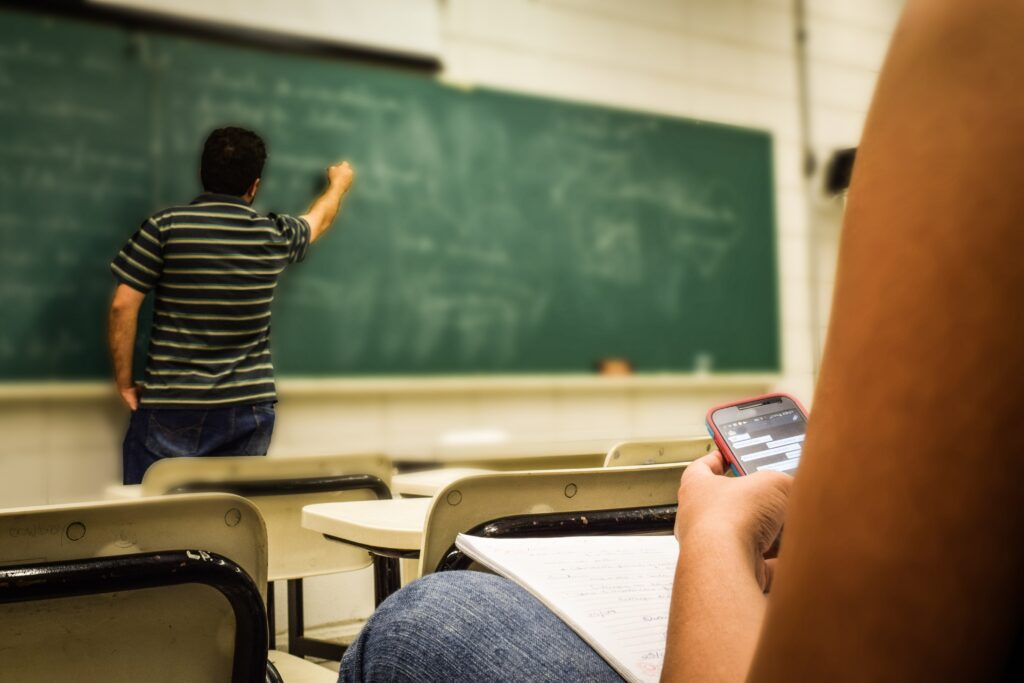Artificial Intelligence (AI) is rapidly transforming the education landscape, providing new ways to personalize learning and improve educational outcomes. AI is being used to create intelligent tutoring systems, adaptive assessments, and learning analytics. In this article, we’ll explore the role of AI in education and how it is changing the way we teach and learn.
What is Artificial Intelligence in Education
Virtually every element of our life is changing due to artificial intelligence, and education is no exception. Artificial intelligence (AI) in education refers to the application of AI in the classroom and the management of the class and course load. AI refers to machines that mimic human perception and decision-making to complete a task.
The UNESCO mandate necessitates a human-centered approach to AI. It strives to reframe the discourse to include AI’s role in addressing present inequities over access to knowledge, research, and the diversity of cultural expressions. In order to ensure that AI does not exacerbate the technical gaps inside and between nations,
The purpose of implementing AI in education, like any other technology, is to enhance student learning and unload administrative duties. The goal of “AI for all” must be to ensure that everyone has access to the benefits of the current technology revolution, particularly in terms of innovation and knowledge.
How Can AI Be Used in Education?

AI in education offers the chance to simplify administrative and teaching responsibilities. Opening up this opportunity allows teachers and administrators to devote more time in supporting students, employees, and other stakeholders.
In all industries, including education, machine learning (ML) and artificial intelligence (AI) are key forces behind innovation and success. While AI-powered technologies have been present in EdTech for some time, the industry has been slow to adopt them.
On the other hand, the pandemic drastically changed the landscape and forced schools to rely on technology for online learning. Currently, 86 percent of educators think technology ought to be a fundamental component of education.
With the help of the education sector, AI has the ability to enhance teaching and learning while concurrently developing to benefit both students and teachers.
The Importance of artificial intelligence in Education
Artificial intelligence has the power to alter the way we teach and learn. This is because of its remarkable potential to enhance educational outcomes and boost student success. AI is already altering the face of education in a variety of ways, from individualized learning experiences to state-of-the-art evaluation systems.
List of Artificial Intelligence in Education
Student and Class Comprehension

Teachers currently have a few alternatives for calculating student test results. They can further assess students’ broad understanding of many disciplines with the use of AI systems.
For instance, using AI-driven insights, teachers can determine a class’s or a student’s level of understanding of a subject. Teachers can get this data from individual and group performance on assignments and assessments.
Then, based on individual knowledge gaps, teachers can use this data to decide whether they need to revisit certain topics. This information could assist district personnel and officials in determining whether such issues are broadly understood in classrooms and other schools. This is similar to how it could inform curriculum modifications or point out areas that want improvement
Grading software
Machine Learning algorithms are employed by AI-powered grading software to create grading systems. They can do this after gathering crucial data on metrics for grading assignments. The tools can comprehend and imitate the former grading procedure used by teachers. Teachers, with the use of AI, can quickly and accurately grade essays, and papers, in a variety of languages.
Teachers can easily integrate this kind of AI into a virtual environment or cloud-based platform that already exists. When there are a lot of papers, they come in helpful so that the professors can focus on other important work rather than spending hours marking papers.
Attendance Taking

Administrators and office personnel can use artificial intelligence (AI) to monitor student attendance. They can also keep track of when reported absences, or alert parents of unannounced absences or tardiness.
By automating attendance taking, administrators and office staff may focus their efforts on more crucial activities. This includes offering instructors and students the support they need, as well as visitors and other people who contact or visit the facility.
Voice assistants
Voice assistants offer a practical and enjoyable means of extending learning beyond the classroom. Educators can use them to plan study schedules, listen to coaching instructions, and provide quick answers to inquiries from students.
Even if a smartphone lacks smart speakers, educators can access these AI-powered voice assistants in apps.
Personalized learning

AI solutions can support learning by creating personalized study regimens and customizing instruction to meet the needs of each learner. In addition to developing curriculum and feedback mechanisms, they also detect knowledge gaps.
Students have the flexibility to study at their own pace and repeat as needed to suit their individual learning requirements. They can do this with the use of AI-powered software, games, and other resources.
Machine-assisted classroom settings can assist teachers in customizing lesson plans to meet the unique needs of each student. It can go a long way in differentiating and adapting learning that can lay a strong foundation for all types of learners.
Real-Time Notes
By recording lectures and utilizing speech-to-text technologies, AI systems can also assist students who have visual or aural impairments.
Also, teachers or administrators can use AI to construct a transcript synchronized with an audio recording of the class. This allows students to go back and listen or read what a teacher said at a particular moment. This is important if they were having difficulties paying attention in class or are busy taking notes.
Teachers also gain time since they are not required to provide students their own recaps and notes for each lesson.
Essay Scoring
Instructors can check for language, sentence structure, and plagiarism in student essays using AI algorithms. AI can also check to determine if students understand their tasks and whether they accurately responded to the prompt.
Teachers can have an AI system perform a first pass on each essay before conducting their own evaluation. This can save them countless hours that they can instead use working one-on-one with students or on other important duties.
Intelligent tutoring
Artificial intelligence-based tutoring software are capable of handling individualized feedback and guidance for one-on-one education. They are also known as intelligent tutoring systems (ITS). They cannot take the role of teachers, though, as they are unable to impart knowledge in the same way that humans can.
When human tutors are not accessible for brief courses that students can take online, ITSes can be useful. Educators can also use this tutoring software in other ways. They can teach languages, geography, circuits, medical diagnostics, computer programming, mathematics, physics, genetics, chemistry, and other subjects in e-learning platforms.
Developers created these platforms with student engagement, grading criteria, and comprehension in mind.
Virtual learning environment
Students can access interactive content by connecting to their devices using VR technologies. Educators can facilitate different activities in virtual environments using this kind of AR. This includes group educational experiences, student counseling services, and other immersive learning experiences.
By reducing distractions and extending attention spans, VR headsets can benefit students who have ADD/ADHD. Students can also coach other students in soft skills, life skills, and self-development.
Admin tasks
AI can accomplish different manual administration tasks including class scheduling, rescheduling, and noting attendance. It can also grade papers, finances, bookkeeping, and record-keeping in educational institutions of all levels.
This streamlines the routine, boring duties that the personnel is no longer required to complete. Artificial intelligence makes it possible for educators to put less emphasis on tedious paperwork and more emphasis on raising educational standards.
The disadvantages of artificial intelligence in education
The use of too many AI-powered educational tools may have a negative effect on students, even while AI can offer tailored learning and fast feedback. It cannot take the place of the human and emotional support that students require to achieve.
Although acknowledging the potential advantages that AI may bring to education, it is crucial to take into account these potential drawbacks and try to mitigate them.
There are ways to make sure that educators use AI to its greatest potential while limiting any negative effects. It requires a thorough and balanced strategy to incorporate technology into the educational system.
Job losses
Developers can automate certain tasks in several vocations using AI. This includes those in the education sector. While this might result in greater efficiency, it might also mean job losses and financial instability for teachers.
Lack of human interaction

AI-powered platforms and technologies can limit opportunities for classroom collaboration and human engagement. These can be essential elements of a well-rounded education.
Bias and discrimination
The data that developers teach AI systems determine how objective they are. The AI system may maintain prejudices in its judgments and suggestions if the data contains biases or discriminating information.
Privacy concerns
Educators need large amounts of student data to integrate artificial intelligence in their education system. This raises concerns regarding privacy and the security of sensitive data.
Dependence on technology

We may lose the ability to solve problems and exercise critical thinking on our own. This is a consequence of relying increasingly on AI platforms and technologies. And so, it is essential to advance artificial intelligence skills through upskilling AI Training programs.
Examples of artificial intelligence in education: Tools and platforms for the classroom
Artificial intelligence developers are creating new platforms and technologies for the education sector. These are a few instances of how AI is already transforming education:
-
Platforms for personalized learning
AI-powered systems like Knewton and Carnegie Learning employ data and algorithms. They do this to provide each student with a unique learning experience. This includes specially-tailored recommendations and comments that address each student’s needs.
-
Tools for adaptive assessment
AI-powered programs like Gradescope and Kaltura give teachers immediate feedback on their students’ performance. Using these platforms enables them to evaluate and revise their lessons in real-time.
-
Virtual instructors
AI-powered virtual tutors like Carnegie Learning’s ALEKS and Querium can give students access to excellent educational materials and support around the clock.
-
Speech and language tools
AI-powered tools like Cognii assist students to improve their language and communication skills. They feature real-time feedback and individualized learning experiences.
The Future of AI in Education
There is a growing consensus that the extraordinary range of present and potential benefits will prevail. This is despite the fact that there is still much debate about the advantages and disadvantages of implementing AI technology in the field of education. It includes the depersonalization worries and the ethical issues we’ve discussed.
FAQs
To what extent will education be impacted by artificial intelligence?
Artificial intelligence has already impacted the education sector. Many experts expect that this trend will only continue to grow. Teachers can concentrate more on teaching and giving individualized feedback to students. They can do this by automating administrative activities like grading with AI.
With interactive and tailored learning resources, AI-powered educational solutions can improve students’ learning experiences. These can be intelligent tutoring systems that can adjust to a student’s specific needs and learning pace. A good example is a platform like FreeFuse.
It’s vital to remember that educators should only use artificial intelligence to supplement and improve their efforts, not to replace them. So, how teachers deploy and use AI in practice will determine its impact on education.
What is the future of AI in education in the online sector?
The use of AI in online education has a bright future and has the potential to completely change how we learn. AI is able to assess learning data for each individual student and customize instruction to meet their specific needs and learning preferences.
This implies that students might get a learning experience that suits their needs, interests, and speed. AI-powered tutoring solutions enable students to learn at their own pace and receive assistance as needed. They can obtain quick feedback and guidance.
These programs can also monitor students’ development and modify the difficulty level as necessary.
In general, AI has the power to change how we learn and teach, improving education through personalization, engagement, and effectiveness. It’s crucial to keep in mind, though, that artificial intelligence is merely a tool to supplement and support human teachers and mentors, not to replace them.
How can AI be used to improve the education system?
Artificial intelligence can aid students in learning more effectively and quickly. It is even more effective if used in conjunction with excellent learning resources and training,
AI technologies can also assist pupils in getting back on track more quickly by warning teachers of issues that the human eye cannot perceive.
AI has the ability to revolutionize the educational system by enhancing student learning through individualized, effective instruction, assistance for teachers, and increased accessibility for all students.





